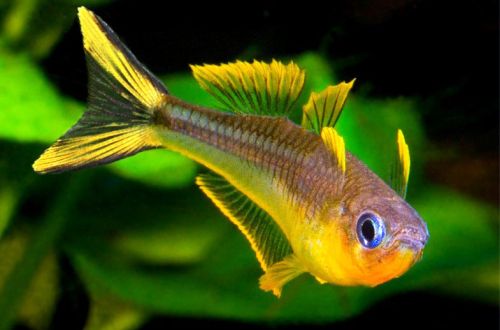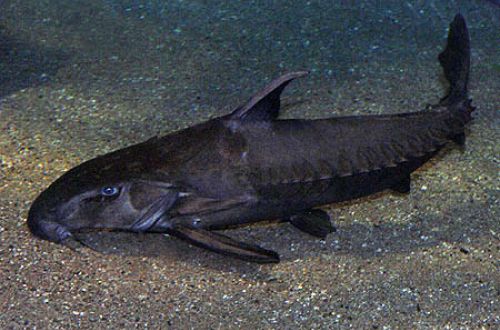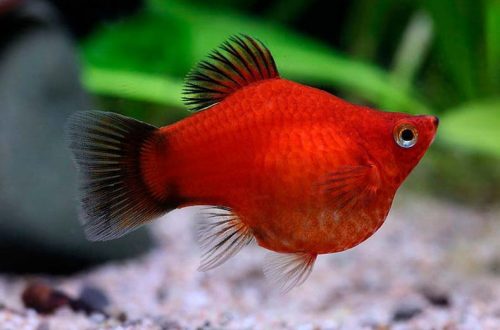
Fork-tailed blue-eye
The fork-tailed blue-eye or Popondetta furcatus, scientific name Pseudomugil furcatus, belongs to the Pseudomugilidae family. Beautiful bright fish that can decorate any freshwater aquarium. Appeared in the aquarium trade relatively recently since the 1980s. Fish are not caught from the wild, all specimens for sale are grown in the artificial environment of commercial and amateur aquariums.

Contents
Habitat
Endemic to the island of New Guinea, lives in the river basins flowing into Collingwood and Dyke Ekland bays, washing the eastern tip of the island. Prefers clean and calm sections of rivers rich in aquatic vegetation, flowing among tropical forests. The natural habitat is subject to seasonal changes. During monsoon periods, heavy rainfall raises water levels in rivers, lowering temperatures and washing away a lot of organic matter from the forest floor. During dry periods, partial drying up of the beds of small rivers is not uncommon.
Brief information:
- The volume of the aquarium – from 60 liters.
- Temperature – 24-28°C
- Value pH — 7.0–8.0
- Water hardness – medium to high (15-30 dGH)
- Substrate type – any
- Lighting – subdued
- Brackish water – no
- Water movement is weak
- The size of the fish is up to 6 cm.
- Meals – any
- Temperament – peaceful
- Keeping a flock of at least 8-10 individuals
Description
Adult individuals reach a length of up to 4–6 cm. Males are somewhat larger and brighter than females, and also have more elongated fins. The predominant color is yellow, males may show red tints on the underside of the body. A characteristic feature of the species is the blue edging on the eyes, which is reflected in the name of these fish.
Food
Accepts all types of food of suitable size – dry, live and frozen. It is recommended to feed live food at least several times a week, for example, bloodworms, brine shrimp, so that the nutrition is balanced.
Arrangement of an aquarium
The volume of the aquarium for a small flock of fish starts from 60 liters. In the design, a lot of rooting and floating plants are used, arranged in groups, and several snags in the form of roots or tree branches will also not be superfluous.
When choosing and installing equipment, it is worth remembering that the Fork-tailed blue-eye prefers subdued lighting levels and oxygen-rich water, and also does not tolerate water flow, so select the appropriate lighting and filtration systems.
Behavior and Compatibility
Peaceful and calm fish, perfectly suited to the community of species similar in temperament and size. Keeping a flock of at least 8-10 individuals of both sexes. This will allow Blue Eyes to feel more comfortable and bring out her best colors. The latter is especially true for males, who will compete with each other for the attention of females, and coloring is the tool of struggle.
Breeding / breeding
Breeding is simple, but the offspring are likely to be sickly and more than half of the eggs in the clutch will be empty. The reason is this – most of the fish on sale are descendants of the first population, which was taken from the island in 1981. As a result of closely related crossings, the gene pool has suffered significantly.
In a home aquarium, fish can give birth throughout the year. Spawning in one female lasts only one day and occurs near thickets of low-growing small-leaved plants, among which eggs are laid. At the end of the mating season, parental instincts fade and the fish can eat their own eggs and fry. In order to protect future offspring, the eggs are placed in a separate tank with identical water conditions, equipped with a simple airlift filter with a sponge.
It is worth noting that the fry can also grow in the general aquarium if reliable shelters are provided for them from dense floating vegetation, since at a young age they stay in the upper layers of the water.
The incubation period lasts about 3 weeks, the duration depends on the water temperature. Feed with specialized powdered food for fish fry, or live food – small daphnia, brine shrimp nauplii.
Fish diseases
Health problems arise only in case of injuries or when kept in unsuitable conditions, which depresses the immune system and, as a result, provokes the occurrence of any disease. In the event of the appearance of the first symptoms, first of all, it is necessary to check the water for the excess of certain indicators or the presence of dangerous concentrations of toxic substances (nitrites, nitrates, ammonium, etc.). If deviations are found, bring all values back to normal and only then proceed with treatment. Read more about symptoms and treatments in the Aquarium Fish Diseases section.





